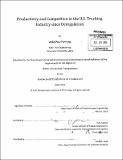| dc.contributor.advisor | Chris Caplice. | en_US |
| dc.contributor.author | Parming, Veiko Paul | en_US |
| dc.contributor.other | Massachusetts Institute of Technology. Department of Civil and Environmental Engineering. | en_US |
| dc.date.accessioned | 2013-12-06T20:48:43Z | |
| dc.date.available | 2013-12-06T20:48:43Z | |
| dc.date.issued | 2013 | en_US |
| dc.identifier.uri | http://hdl.handle.net/1721.1/82846 | |
| dc.description | Thesis (S.M. in Transportation)--Massachusetts Institute of Technology, Department of Civil and Environmental Engineering, 2013. | en_US |
| dc.description | Cataloged from PDF version of thesis. | en_US |
| dc.description | Includes bibliographical references (pages 105-107). | en_US |
| dc.description.abstract | In 1980 Congress passed the Motor Carrier Act, substantially liberating trucking carriers from a federal regulatory structure that had exercised broad economic control over the industry for over four decades. Changes in the industry were swift and extensive. This thesis returns to the transformational period encompassing the deregulatory and post-deregulatory years. Using the Motor Carrier Annual Reports (Form M) dataset, the thesis sets its focus as physical productivity at the firm level, and analyzes the truckload (TL) and less-than-truckload (LTL) sectors separatIy. The Form M dataset covers the years 1977-1992; the baseline for cumulative analysis is set as 1979, the eve of the Motor Carrier Act. The productivity analysis is contextualized within a wider account of industry changes, including substantial declines in unit costs. The thesis goes on to present a framework for understanding how deregulation engendered changes in competition and productivity. Physical multifactor productivity (MFP) growth in the years 1979-1992 is found to average 1.6% p.a. for TL and 1.0% p.a. for LTL. After initial productivity stagnation, MFP growth from 1983 on was 2.0% and 1.7% p.a. for TL and LTL, respectively. This is suggestive of steady improvement in efficiency, if not a productivity revolution. Although productivity growth was modest, it played a significant role in cutting unit costs. Between 1979-1992 real unit costs declined by 39% for the truckload sector; productivity factors were associated with a 17% reduction while input price factors were responsible for a 20% reduction. For the LTL sector, the decline in unit costs was 17%, with productivity responsible for a 7% drop and input price factors, an 11% drop. The unit cost savings enabled carriers to offer lower real output prices to shippers. | en_US |
| dc.description.statementofresponsibility | by Veiko Paul Parming. | en_US |
| dc.format.extent | 123 pages | en_US |
| dc.language.iso | eng | en_US |
| dc.publisher | Massachusetts Institute of Technology | en_US |
| dc.rights | M.I.T. theses are protected by
copyright. They may be viewed from this source for any purpose, but
reproduction or distribution in any format is prohibited without written
permission. See provided URL for inquiries about permission. | en_US |
| dc.rights.uri | http://dspace.mit.edu/handle/1721.1/7582 | en_US |
| dc.subject | Civil and Environmental Engineering. | en_US |
| dc.title | Productivity and competition in the U.S. trucking industry since deregulation | en_US |
| dc.type | Thesis | en_US |
| dc.description.degree | S.M.in Transportation | en_US |
| dc.contributor.department | Massachusetts Institute of Technology. Department of Civil and Environmental Engineering | |
| dc.identifier.oclc | 863229316 | en_US |
